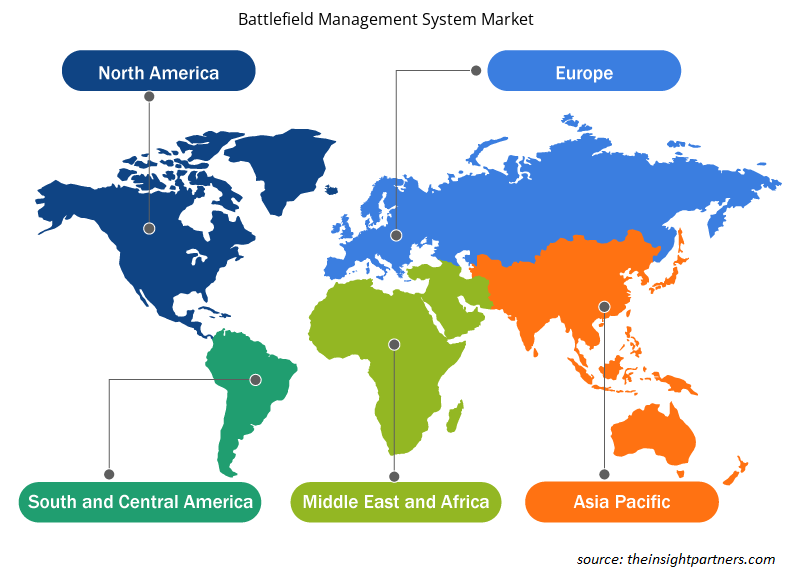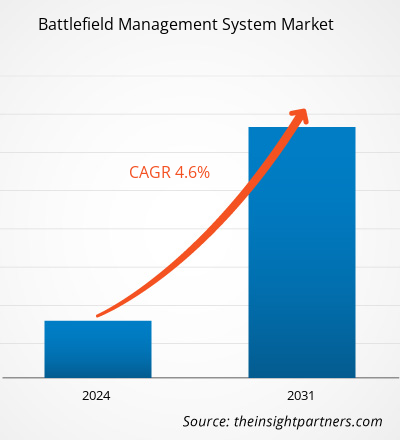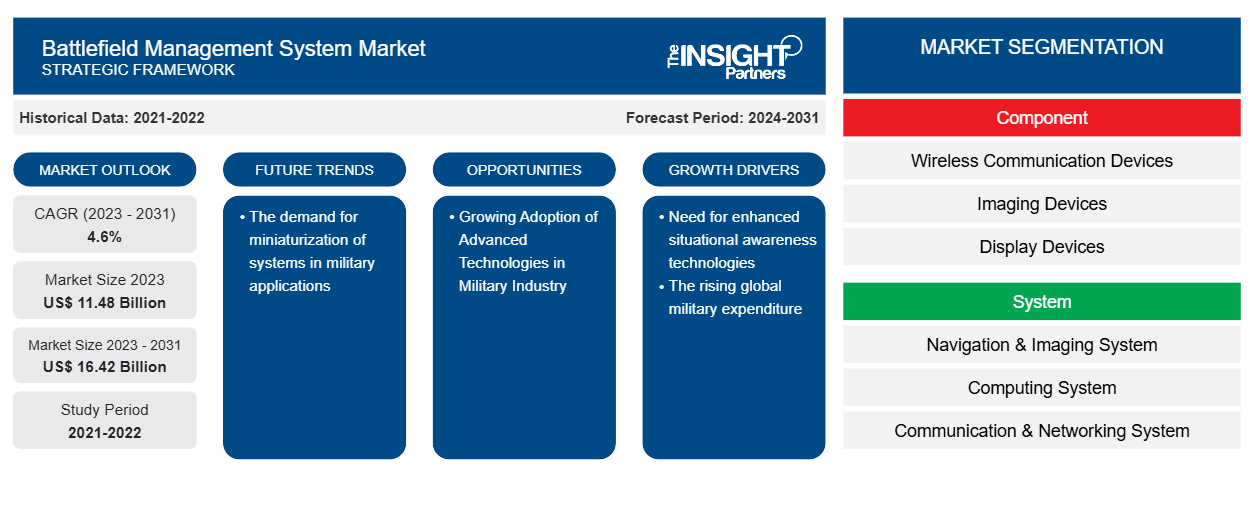من المتوقع أن يصل حجم سوق أنظمة إدارة ساحة المعركة إلى 16.42 مليار دولار أمريكي بحلول عام 2031 من 11.48 مليار دولار أمريكي في عام 2023. ومن المتوقع أن يسجل السوق معدل نمو سنوي مركب بنسبة 4.6٪ خلال الفترة 2023-2031. ومن المرجح أن يظل الطلب على تصغير الأنظمة في التطبيقات العسكرية اتجاهًا رئيسيًا في السوق.
تحليل سوق نظام إدارة ساحة المعركة
يشتمل السوق في المقام الأول على مطوري البرامج ومطوري الأنظمة ومتكاملي الأنظمة والمستخدمين النهائيين. ويتكون اللاعبون في السوق بشكل أساسي من مطوري البرامج مثل Atos وSystematic وRolta، الذين يقدمون حلولاً قائمة على البرامج لإدارة ساحة المعركة من خلال خبرتهم الفنية. مطورو الأنظمة هم مصنعو الأجهزة الذين هم رواد هذا السوق حيث يحصلون على اتصالات من قوات عسكرية مختلفة. يعمل مطورو البرامج ومطورو الأنظمة بطريقة متزامنة. بمجرد تطوير النظام والبرنامج، يمرر مطورو النظام الحلول إلى متكاملي الأنظمة، الذين يقومون في النهاية بدمج البرنامج في النظام، والذين يقومون بعد ذلك بتسليم نظام إدارة الأسلحة للقوات المسلحة. يعمل مطورو الأنظمة المختلفون أيضًا كمتكاملين للأنظمة ويوفرون النظام بأكمله للمستخدمين النهائيين بشكل مباشر. يتألف المستخدمون النهائيون من قوات مسلحة مختلفة في جميع أنحاء العالم، ويمثلون جانب الطلب في السوق.
نظرة عامة على سوق نظام إدارة ساحة المعركة
حاليًا، يتكون سوق نظام إدارة ساحة المعركة من لاعبين كبار وراسخين في السوق مع قاعدة عملاء كبيرة. علاوة على ذلك، فإن حواجز الدخول الكبيرة جنبًا إلى جنب مع ميل الحكومة نحو مكافأة المشاركات التجارية الطويلة السابقة قد ساهمت أيضًا في انخفاض التهديد من الداخلين الجدد إلى سوق نظام إدارة ساحة المعركة. ومع ذلك، من المتوقع أن تعمل التخفيضات الأخيرة في الميزانية بالإضافة إلى زيادة الطلب على التخطيط اللوجستي والإدارة والتشغيل المتفوقة على تخفيف الحواجز أمام العروض اللوجستية المختارة. على سبيل المثال، من المتوقع أن توفر فرص الخدمات اللوجستية المحسنة مثل الاستشارات والتحسين والتكامل ودعم التقنيات المتقدمة جنبًا إلى جنب مع دعمها اللوجستي حواجز دخول معتدلة خلال السنوات القادمة.
قم بتخصيص هذا التقرير ليناسب متطلباتك
ستحصل على تخصيص لأي تقرير - مجانًا - بما في ذلك أجزاء من هذا التقرير، أو تحليل على مستوى الدولة، وحزمة بيانات Excel، بالإضافة إلى الاستفادة من العروض والخصومات الرائعة للشركات الناشئة والجامعات
-
احصل على أهم اتجاهات السوق الرئيسية لهذا التقرير.ستتضمن هذه العينة المجانية تحليلاً للبيانات، بدءًا من اتجاهات السوق وحتى التقديرات والتوقعات.
محركات وفرص سوق نظام إدارة ساحة المعركة
الحاجة إلى تقنيات معززة للوعي الظرفي
إن الوعي بالموقف أو الوعي بالموقع أمر بالغ الأهمية أثناء المعركة. حيث تقدم ساحة المعركة العديد من التحديات للوعي بالموقف، مما يشكل تهديدًا كبيرًا للجنود الراجلين وكذلك المركبات. ويرجع هذا إلى حقيقة أن الأعداء أو القوات المسلحة تستخدم تقنيات متقدمة، مما يخلق موقفًا صعبًا للقوات المسلحة أثناء اتخاذ القرار. والهدف الأساسي من BMS هو التغلب على مثل هذه التحديات بطريقة فعالة من خلال مساعدة الجنود على التفكير والتصرف بسرعة. ويعتبر BMS لزيادة الوعي بالموقف، وخاصة في المواقف التي تكون فيها إمكانية تتبع العدو منخفضة. كما أنه يساعد في التعرف على وفهم العناصر الحاسمة للمعلومات المتعلقة بنشاط الفريق، وخاصة في ساحة المعركة.
تزايد استخدام التقنيات المتقدمة في الصناعة العسكرية
يهدف القطاع العسكري في جميع أنحاء العالم إلى تحسين قدراته البرية والجوية والبحرية من خلال العديد من التطورات التكنولوجية. تتطلب الأنشطة عبر الحدود المتزايدة والمواقف التي لا مفر منها عبر الحدود أنظمة تقنية متقدمة. يلعب الذكاء الاصطناعي، عندما يتم دمجه مع الأسلحة والطائرات بدون طيار وغيرها من المنتجات، دورًا رئيسيًا في القطاع العسكري. لا يزال البحث في مجال الذكاء الاصطناعي مستمرًا في مجالات جمع وتحليل المعلومات الاستخبارية والقيادة والسيطرة وفي مجموعة متنوعة من المركبات، وقد تم دمجه في العمليات العسكرية في سوريا والعراق. تراهن الصين على الذكاء الاصطناعي لتحسين قدراتها الدفاعية ومن المتوقع أن تصبح الرائدة عالميًا في مجال الذكاء الاصطناعي بحلول عام 2030. تركز حاليًا على استخدام الذكاء الاصطناعي لاتخاذ قرارات مستنيرة وأسرع وبناء مجموعة متنوعة من المركبات العسكرية المستقلة. كما تعمل روسيا بنشاط في دمج الذكاء الاصطناعي في التقنيات العسكرية، مع التركيز بشكل كبير على الروبوتات. ومن المرجح أن توفر مثل هذه العوامل فرصًا مستقبلية في السنوات القادمة.
تقرير تحليل تجزئة سوق نظام إدارة ساحة المعركة
إن القطاعات الرئيسية التي ساهمت في اشتقاق تحليل سوق نظام إدارة ساحة المعركة هي المكون والنظام والتطبيق.
- بناءً على المكون، يتم تقسيم سوق نظام إدارة ساحة المعركة إلى أجهزة اتصال لاسلكية وأجهزة تصوير وأجهزة عرض وبرامج كمبيوتر وأجهزة تتبع. احتل قطاع أجهزة الاتصال اللاسلكية حصة سوقية أكبر في عام 2023.
- بناءً على النظام، يتم تقسيم سوق أنظمة إدارة ساحة المعركة إلى أنظمة الملاحة والتصوير وأنظمة الحوسبة ونظام الاتصالات والشبكات. احتل قطاع أنظمة الاتصالات والشبكات حصة سوقية أكبر في عام 2023.
- بناءً على التطبيق، يتم تقسيم سوق نظام إدارة ساحة المعركة إلى المركبات والجنود والمقر الرئيسي. احتلت شريحة المقر الرئيسي حصة سوقية أكبر في عام 2023.
تحليل حصة سوق نظام إدارة ساحة المعركة حسب المنطقة الجغرافية
ينقسم النطاق الجغرافي لتقرير سوق نظام إدارة ساحة المعركة بشكل أساسي إلى خمس مناطق: أمريكا الشمالية وأوروبا ومنطقة آسيا والمحيط الهادئ والشرق الأوسط وأفريقيا وأمريكا الجنوبية.
سيطرت أمريكا الشمالية على السوق في عام 2023 تليها منطقتي أوروبا وآسيا والمحيط الهادئ. علاوة على ذلك، من المرجح أيضًا أن تشهد منطقة آسيا والمحيط الهادئ أعلى معدل نمو سنوي مركب في السنوات القادمة. سيطرت الولايات المتحدة على سوق نظام إدارة ساحة المعركة في أمريكا الشمالية في عام 2023. ويرجع ذلك إلى وجود أكبر دولة تنفق عسكريًا أي الولايات المتحدة والتي تضم أيضًا بعض اللاعبين الرئيسيين العاملين في سوق نظام إدارة ساحة المعركة. تشمل بعض اللاعبين الرئيسيين الذين لديهم حضور في سوق نظام إدارة ساحة المعركة في أمريكا الشمالية بائعين مثل BAE Systems Plc و General Dynamics Corporation و Raytheon Technologies Corporation و L3Harris Technologies Inc و Lockheed Martin Corporation و Northrop Grumman Corporation.
نطاق تقرير سوق نظام إدارة ساحة المعركة
رؤى إقليمية حول سوق نظام إدارة ساحة المعركة
لقد قام المحللون في Insight Partners بشرح الاتجاهات والعوامل الإقليمية المؤثرة على سوق نظام إدارة ساحة المعركة طوال فترة التوقعات بشكل شامل. يناقش هذا القسم أيضًا قطاعات سوق نظام إدارة ساحة المعركة والجغرافيا في جميع أنحاء أمريكا الشمالية وأوروبا ومنطقة آسيا والمحيط الهادئ والشرق الأوسط وأفريقيا وأمريكا الجنوبية والوسطى.

- احصل على البيانات الإقليمية المحددة لسوق نظام إدارة ساحة المعركة
نطاق تقرير سوق نظام إدارة ساحة المعركة
| سمة التقرير | تفاصيل |
|---|---|
| حجم السوق في عام 2023 | 11.48 مليار دولار أمريكي |
| حجم السوق بحلول عام 2031 | 16.42 مليار دولار أمريكي |
| معدل النمو السنوي المركب العالمي (2023 - 2031) | 4.6% |
| البيانات التاريخية | 2021-2022 |
| فترة التنبؤ | 2024-2031 |
| القطاعات المغطاة |
حسب المكون
|
| المناطق والدول المغطاة |
أمريكا الشمالية
|
| قادة السوق وملفات تعريف الشركات الرئيسية |
|
كثافة اللاعبين في سوق نظام إدارة ساحة المعركة: فهم تأثيرها على ديناميكيات الأعمال
يشهد سوق أنظمة إدارة ساحة المعركة نموًا سريعًا، مدفوعًا بالطلب المتزايد من المستخدم النهائي بسبب عوامل مثل تفضيلات المستهلك المتطورة والتقدم التكنولوجي والوعي المتزايد بفوائد المنتج. ومع ارتفاع الطلب، تعمل الشركات على توسيع عروضها والابتكار لتلبية احتياجات المستهلكين والاستفادة من الاتجاهات الناشئة، مما يؤدي إلى زيادة نمو السوق.
تشير كثافة اللاعبين في السوق إلى توزيع الشركات أو المؤسسات العاملة في سوق أو صناعة معينة. وهي تشير إلى عدد المنافسين (اللاعبين في السوق) الموجودين في مساحة سوق معينة نسبة إلى حجمها أو قيمتها السوقية الإجمالية.
الشركات الرئيسية العاملة في سوق نظام إدارة ساحة المعركة هي:
- شركة بي أيه إي سيستمز
- شركة إلبيت سيستمز المحدودة
- شركة جنرال داينامكس
- شركة L3Harris Technologies
- ليوناردو اس بي ايه
- شركة رايثيون تكنولوجيز
إخلاء المسؤولية : الشركات المذكورة أعلاه ليست مرتبة بأي ترتيب معين.

- احصل على نظرة عامة على أهم اللاعبين الرئيسيين في سوق نظام إدارة ساحة المعركة
أخبار السوق والتطورات الأخيرة لنظام إدارة ساحة المعركة
يتم تقييم سوق نظام إدارة ساحة المعركة من خلال جمع البيانات النوعية والكمية بعد البحث الأولي والثانوي، والتي تتضمن منشورات الشركات المهمة وبيانات الجمعيات وقواعد البيانات. فيما يلي بعض التطورات في سوق نظام إدارة ساحة المعركة:
- وقعت شركة لوكهيد مارتن أستراليا عقدًا تاريخيًا بقيمة 500 مليون دولار أسترالي مع وزارة الدفاع لبناء نظام إدارة المعارك الجوية المشتركة في أستراليا في المستقبل بموجب المشروع - المرحلة الأولى من AIR6500 (AIR6500-1). سيوفر هذا النظام لوزارة الدفاع قدرة دفاعية جوية وصاروخية متكاملة متقدمة، باستخدام تقنيات الجيل التالي، لمكافحة التهديدات عالية السرعة. (المصدر: شركة لوكهيد مارتن، بيان صحفي، أبريل 2024)
- منحت وزارة الدفاع البريطانية شركة BAE Systems عقدًا بقيمة 89 مليون جنيه إسترليني لتعزيز الاتصال في الخطوط الأمامية للأفراد العسكريين، وربط طائرات الاستطلاع الصغيرة والمركبات القتالية والطائرات المقاتلة وحاملات الطائرات والقيادات العسكرية. (المصدر: BAE Systems Plc، بيان صحفي، أغسطس 2023)
تقرير سوق نظام إدارة ساحة المعركة والتغطية والنتائج المتوقعة
يوفر تقرير "حجم سوق نظام إدارة ساحة المعركة والتوقعات (2021-2031)" تحليلاً مفصلاً للسوق يغطي المجالات التالية:
- حجم سوق نظام إدارة ساحة المعركة وتوقعاته على المستويات العالمية والإقليمية والوطنية لجميع قطاعات السوق الرئيسية التي يغطيها النطاق
- اتجاهات سوق نظام إدارة ساحة المعركة بالإضافة إلى ديناميكيات السوق مثل المحركات والقيود والفرص الرئيسية
- تحليل مفصل لقوى بورتر الخمس
- تحليل سوق نظام إدارة ساحة المعركة يغطي اتجاهات السوق الرئيسية والإطار العالمي والإقليمي واللاعبين الرئيسيين واللوائح والتطورات الأخيرة في السوق
- تحليل المشهد الصناعي والمنافسة الذي يغطي تركيز السوق، وتحليل خريطة الحرارة، واللاعبين البارزين، والتطورات الأخيرة لسوق نظام إدارة ساحة المعركة
- ملفات تعريف الشركة التفصيلية
- التحليل التاريخي (سنتان)، سنة الأساس، التوقعات (7 سنوات) مع معدل النمو السنوي المركب
- تحليل PEST و SWOT
- حجم السوق والقيمة / الحجم - عالمي، إقليمي، بلد
- الصناعة والمنافسة
- مجموعة بيانات إكسل
التقارير الحديثة
تقارير ذات صلة
شهادات العملاء
سبب الشراء
- اتخاذ قرارات مدروسة
- فهم ديناميكيات السوق
- تحليل المنافسة
- رؤى العملاء
- توقعات السوق
- تخفيف المخاطر
- التخطيط الاستراتيجي
- مبررات الاستثمار
- تحديد الأسواق الناشئة
- تحسين استراتيجيات التسويق
- تعزيز الكفاءة التشغيلية
- مواكبة التوجهات التنظيمية























 احصل على عينة مجانية ل - سوق نظام إدارة ساحة المعركة
احصل على عينة مجانية ل - سوق نظام إدارة ساحة المعركة